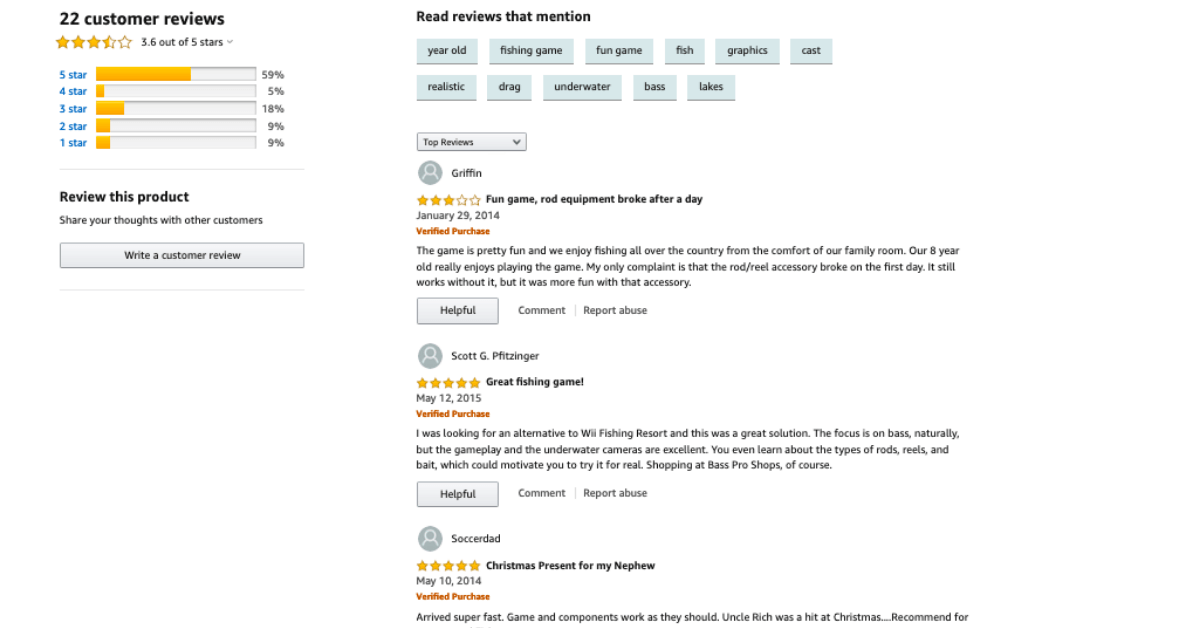There will always be some product returns that are out of a business’s control. However, inaccurate expectations and product information are to blame for 20% of returned products in ecommerce - and product information is one thing that isin a business’s control. That's why businesses should start seeing quality product content as a tool to reduce product returns.
Shoppers are savvy. They know the value of buying online, and that’s why ecommerce has quickly consumed a percentage of sales around the world. So why do over 60% of customers review the return policy before they make a purchase? Because they know there’s a large chance they’ll need to return the product. While this buying model seems to work great for consumers, brands and retailers are the ones who suffer. When customers return products, they’re often left with negative feelings about the brand and are less likely to purchase from the brand again. Plus, those returns take time and money to inspect and resell or liquidate. In short, returns have a direct relationship on churn and wasted resources.
Just by ensuring that product information paints an accurate description you can start to greatly reduce product returns. Here’s what we can do about it.

Assessing the situation: why now and why product information? How could data relate to reduced product returns?
Returning a product in the days of brick-and-mortar required more steps than it does in modern ecommerce. The buyer had to gather the product and receipts and physically drive or walk to the store, where they would then interact with a representative who would work to set things right. For example, offering store credit or replacing the item with another product. Now, in some situations, shoppers can simply put the product back in the box and wait for a carrier to pick it up. There’s no human contact or opportunity to help the customer find an alternative solution.
However, most consumers do not actually want to return products. They want to keep, use, and enjoy the products they buy. This is where product information comes in.
Product information sets the stage for a product. It lays out all of the details and creates expectations in online shoppers. It’s great to optimize product data, ads, and listings for conversions and sales… but you also want sales that don’t turn into returns. That’s why we’re going to pinpoint possible problem areas in product information - the parts that may create false expectations - and use that to create better customer experiences that leave everyone satisfied.
Pinpoint product attributes that confuse or mislead consumers

Titles, descriptions, and shipping speeds that oversell
It’s always smart to put your best foot forward. Highlighting key features and value is what makes a product come to life. Most shoppers don’t want just any product. They want the one with the most exciting specifications, add-ons, and benefits. However, there’s a difference between highlighting the best parts of a product and overstating its (or your own) capabilities.
Shoppers also want to know their products will be delivered quickly. In fact, Kibo’s 2018 Consumer Trends Report found that 63% of online shoppers expect three-day shipping to be the standard. This has tempted some retailers to oversell their shipping speed, advertising faster shipping than they can actually manage. However, even if promising faster shipping can close a deal, it will also create expectations.
If the product can’t be delivered in that amount of time, or the exact capabilities don’t match reality, it might just end up in the returns. Satisfied customers should be the goal. Unwitting buyers only contribute to churn.
Inaccurate size information
When you order a mug and it shows up in a slightly different shade, you probably won’t return it. That mug can still hold coffee and get you through the day. However, when your size 39 boots come in and they don’t fit - you’ll probably return them.
No matter what specific product, size is absolutely central to understanding apparel and shoe items. The first step is to ensure size information is correctly integrated. By including data like “large” or “27x34” in the title, description, and size attributes, it’s much less likely that a shopper will end up with the wrong product.
Businesses can also go beyond this, as “large” may not really describe the size accurately to a reader. For example, ensure that sizing charts include highly specific details. Try mentioning whether a given product line runs small or reflects the size standards used in a specific country.

Unclear or not customer-friendly descriptions
Unfortunately, even a product listing with accurate data can lead to confusion, especially with technology products. It’s not uncommon for shoppers to misread or skim a product listing, leaving them with jumbled or incorrect facts. Avoid this by stating the most important information clearly and, where possible, laid out in an easy-to-follow, visual manner.
Also consider whether the product and its industry may be unclear to shoppers. Imagine you are selling a cable connector. It’s correctly listed as USB C. However, a shopper may not realize that the specific cable could still be incompatible with previous versions. When the shopper gets confused and buys it anyway, they will likely return it.
Step back and view your product information like a consumer. What information is practical and what may be jargon or require background information? Even if the fault is really on the shopper, it will still count as a return.
Imprecise visuals
If you’ve ever ordered a product and received something that looked completely different, you probably thought about returning it. Despite the amazing cameras and editing tools out there, it’s very easy for a product image to inaccurately portray a product. Even if a set of product images can outshine any other on Instagram, that doesn’t mean they accurately portray the product. For example, if a pair of shorts appear two inches longer, or a headset appears more matte than it really is, it won’t match the buyer’s expectation and may be (rightfully) returned.
This visual disconnect is one reason why 30% of all products ordered online are returned, while only 8.89% of those purchased in brick-and-mortar are returned. Shorr
Humans often only know what they do or don’t want when they can personally see it. That’s why product images should be used to give them as close to a first-hand experience as an online shopper can get. Be sure all visuals are of the absolute highest quality. Let shoppers zoom in and feel as if they could practically touch the product. Video is also becoming increasingly popular as a method of visually portraying product information.
In short, do whatever you can to bridge the gap between digital screen and first-hand, real-world experience.
Mine historical data and reviews to locate problems
Products that are often returned are great opportunities. Locate any often-returned products and take a careful look at the way they are presented. Are people regularly returning certain types of products because of poor wording, sizing, or misleading conversion charts?
Product information may be coming from a PIM or other raw system, where data is stored for employees instead of shoppers. On the other hand, it may be carefully crafted by a team of writers and marketers who are looking for conversions instead of correctness. Wherever the data is coming from, ensure that it’s tailored to the customer’s needs.
Lastly, to give your efforts that extra something, mine your existing reviews. Good reviews are great - but bad reviews may also hold information about where problems are happening. Do customers describe what they expected, and then what they actually received?
Automate your cleansing and tailoring, from title to images
It’s great to give products that personal touch. However, if you want to make changes at scale, you’ll need the right toolkit. Productsup makes it easy to locate possible problem areas and quickly apply optimizations in bulk.
No more wondering what your end-customer sees. Use our visualization tools to view your ads on Facebook and Google or listings on Amazon, exactly the way your customer will. Creating the perfect product pages should be simple and rewarding.

![[WP Import] Reduce product returns (and maximize customer happiness) with quality content](http://images.ctfassets.net/q17uls4wkkdz/1zrAuETMtbr7NbwoOZ8Gg6/d56e099d4d051f56dadb2949ae7d5263/19-07-02_Reduce_product_returns_with_quality_product_data_ft_image_800x500.png?w=1200&h=675&fit=FILL)


